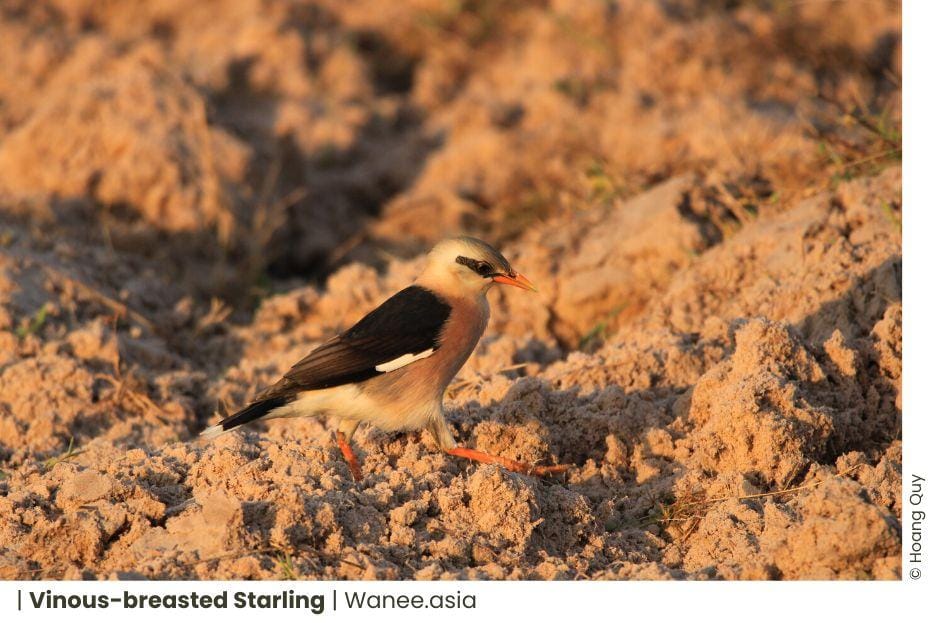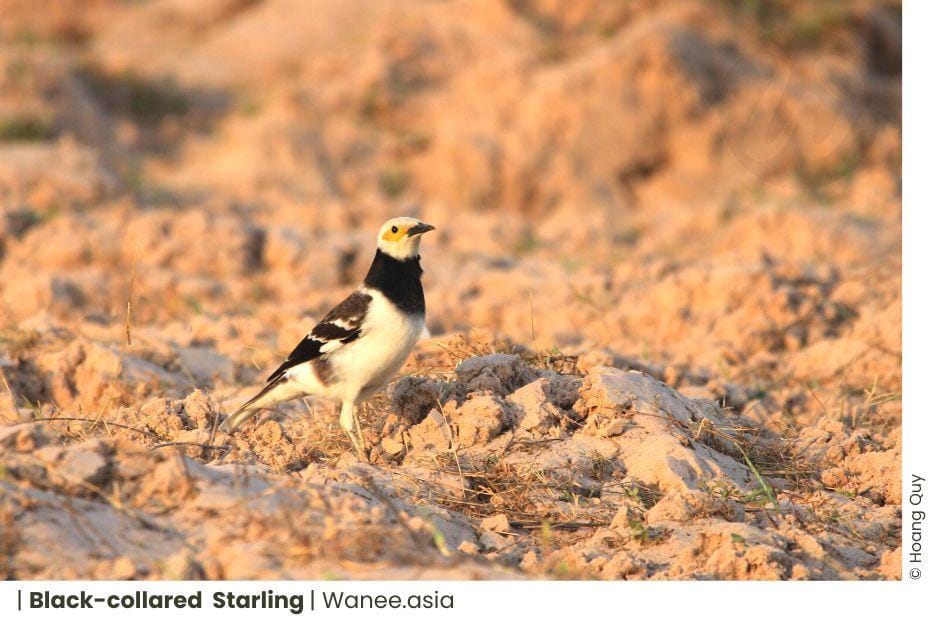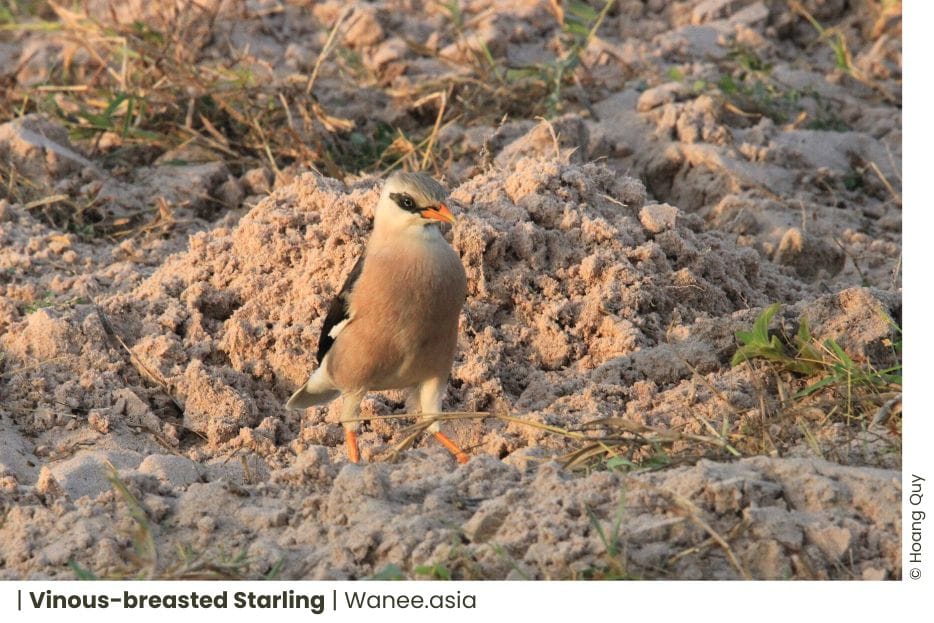Starlings Of Vietnam – Sturnidae
There are 17 species Starlings of Vietnam, all of which belong to the family Sturnidae. These birds are known for their striking plumage and varied vocalizations. While some species are common and widespread, others are rare and only found in specific regions of Vietnam. Starlings occupy a range of habitats, including forests, grasslands, and urban areas.
Their diet varies widely, but typically includes fruits, insects, and other small animals. Some species are migratory, while others are resident year-round. The conservation status of these birds varies from species to species, with some listed as vulnerable or endangered due to habitat loss and other threats.
Appearance
Starlings are small to medium-sized birds with a stocky build and short, triangular wings. They have a short tail and a sharp, pointed bill. The coloration of starlings can vary greatly depending on the species, but many have iridescent feathers that can appear green, purple, or blue in certain lighting conditions. Some species also have distinctive spots, stripes, or other markings on their plumage. Overall, starlings have a sleek and attractive appearance.

Habitats & Distribution
Starlings are a family of birds found worldwide, with a diverse range of habitats and distributions. They are typically found in open habitats such as grasslands, woodlands, and urban areas. Some species are adapted to more specialized habitats, such as the European starling, which is often found in agricultural areas and urban environments.
In Vietnam, there are 17 species of starlings that inhabit a variety of habitats, including forests, grasslands, wetlands, and urban areas. For example, the chestnut-tailed starling is found in lowland forests and open woodlands, while the Asian glossy starling is found in more urbanized areas such as gardens, parks, and cities.

Behavior
Starlings are highly social birds and are known for their synchronized flock movements, or murmurations. They often form large flocks and roost communally, especially during the non-breeding season. During the breeding season, males defend territories and perform courtship displays to attract mates.
Starlings are also known for their vocalizations, which can be highly varied and complex. They are capable of mimicking the sounds of other birds and even human speech. In addition, they are known for their problem-solving abilities, including using tools to obtain food
Starlings are known for their melodious songs, consisting of a series of whistles, trills, and warbles. Some species, such as the Chestnut-tailed Starling, are known for their high-pitched, piercing calls that can carry over long distances. Others, like the White-shouldered Starling, have a variety of calls and songs, including a harsh, raspy sound used to communicate with other members of their flock.

Reproduction
Starlings are generally monogamous and form pair bonds during the breeding season. They are cavity nesters, meaning they nest in holes in trees or other structures such as bird boxes. Both parents help to build the nest and incubate the eggs. The number of eggs laid depends on the species, but typically ranges from 3 to 6 eggs. The eggs are incubated for around 12-14 days before hatching.
Once the chicks hatch, both parents are involved in feeding and caring for them. The chicks grow rapidly and are ready to fledge the nest after about 2-3 weeks. Some species may raise two or even three broods per breeding season.
It’s worth noting that some species of starlings, such as the European Starling, are invasive in certain parts of the world and can cause problems for native bird populations
Conservation Status
The conservation status of starlings varies depending on the species. Some starling species are widespread and considered of least concern, while others are threatened due to habitat loss, hunting, and capture for the pet trade.
List 17 Starlings of Vietnam
| Name | Level | |
| 1 | Asian Glossy Starling | Medium |
| 2 | Golden-crested Myna | Easy |
| 3 | Common Hill Myna | Medium |
| 4 | European Starling | Hard |
| 5 | Rosy Starling | Medium |
| 6 | Daurian Starling | Medium |
| 7 | Chestnut-cheeked Starling | Medium |
| 8 | Black-collared Starling | Easy |
| 9 | White-shouldered Starling | Medium |
| 10 | Brahminy Starling | Medium |
| 11 | Chestnut-tailed Starling | Easy |
| 12 | Red-billed Starling | Medium |
| 13 | White-cheeked Starling | Medium |
| 14 | Common Myna | Easy |
| 15 | Vinous-breasted Myna | Easy |
| 16 | Great Myna | Medium |
| 17 | Crested Myna | Medium |
Crocodile Trail – The Best Birding Trail in Cat Tien National Park
If you’re a birder or nature photographer planning a trip to Vietnam, few places offer [...]
Cong Troi Trail – Top 1 Dalat Plateau Birding Trail Experience
If you’re a birder or nature photographer planning a trip to Vietnam’s Central Highlands, the [...]
How to Identify the Greater Sand Plover, Tibetan Sand Plover and Siberian Sand Plover
ContentsStarlings Of Vietnam – SturnidaeAppearanceHabitats & DistributionBehaviorReproductionConservation StatusList 17 Starlings of VietnamAll Vietnam Birds FamiliesIdentification [...]
Highlights of Cat Tien National Park Reptiles and Amphibian Endemics
Spanning over 71,350 hectares of tropical forests, grasslands, and wetlands, Cat Tien National Park is [...]
Highlights of Cat Tien National Park Mammals in a World Biosphere Reserve
In addition to reptiles and birds, Cat Tien National Park is also rich in mammals, [...]
Kontum Plateau Endemic and Highlight bird
Kontum Plateau Endemic And Highlight Bird species like Chestnut-eared Laughingthrush and top birding routes while [...]